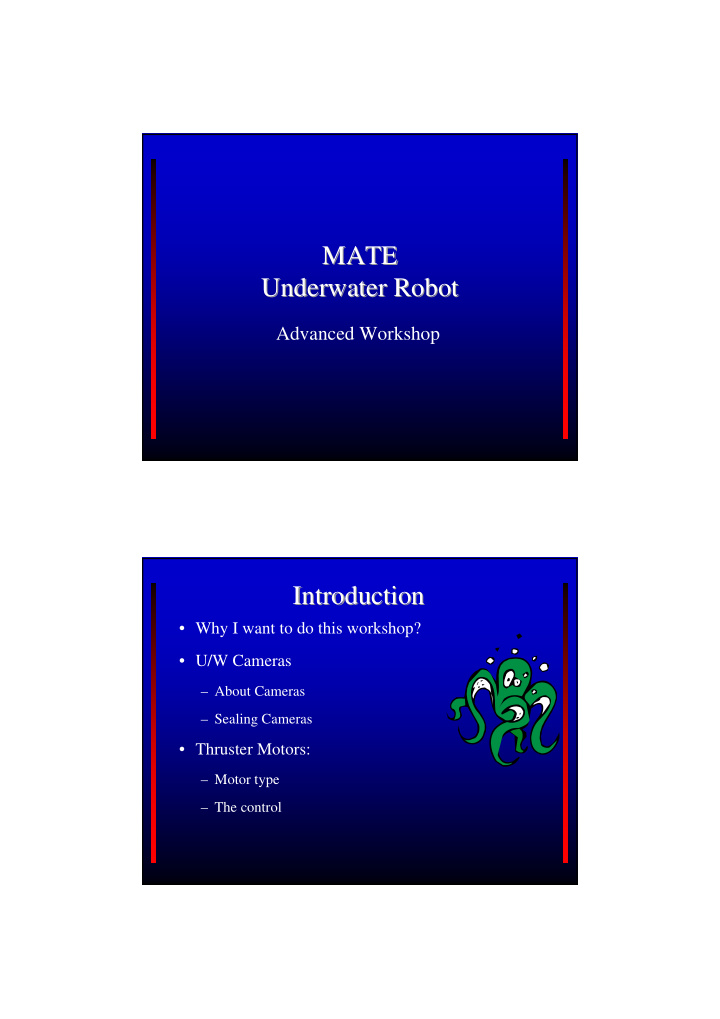



MATE MATE Underwater Robot Underwater Robot Advanced Workshop Introduction Introduction • Why I want to do this workshop? • U/W Cameras – About Cameras – Sealing Cameras • Thruster Motors: – Motor type – The control
Introduction Introduction • Ancillary (supplementary) Motors: – Motor type – The control • LUNCH Introduction Introduction • Other Stuff: – Camera Power supply – Troubleshooting PWM Circuits – Temp Sensor – Joining wires – O-rings – Questions
Underwater Cameras Underwater Cameras • Why do we need them? • Several ways to make a camera waterproof – Inside a sealed box. – Epoxy’ed. The Car rear view camera Model The Car rear view camera Model ENOCH- ENOCH -1032 1032
The Camera Frame The Camera Frame How we are doing this • Two teams will come up here at a time. – To weigh out the epoxy. – To mix it thoroughly. – To pour it into the camera tube. – To fit the gland into the tube.
DC Motors DC Motors • Three types : – Stepper Motors. – RC Servo Motors. – Conventional DC Motors. Stepper Motors Stepper Motors • Very precise in terms of position • Full rotation possible • Special connection to multiple coils in the motor • The coils are energized in a sequence to make the motor rotate • The speed is controlled by the rate the sequence occurs
Stepper Motors Stepper Motors Servo Motors Servo Motors • Very precise in terms of position • Partial rotation only. • Feedback signal is used to determine the position of rotation • High overhead in maintaining positioning signal
Servo Motors Servo Motors Conventional Motors Conventional Motors • Speed control possible • Can be feedback control • Simple on/off switched • Pulse Width Modulation (PWM) Control.
Conventional Motors Conventional Motors Thruster Motors Thruster Motors • Standard DC Motors • Main drive for the robot • Simple on/off - Reverse Switch or PWM Control.
On / Off / Reverse Switch On / Off / Reverse Switch One for each motor
What is PWM? What is PWM? • PWM = Pulse Width Modulation. • It is the switching off and on of a power supply for different time periods. Faster speed Full on Slow speed PWM Signal Generation PWM Signal Generation
Electronic Control Electronic Control How is this used for Motor Control? How is this used for Motor Control? Power PWM signal Electronic Generation Power Switch Motor Speed Direction Control Control
Discrete Electronics Discrete Electronics Kitsrus DIY Kit 67 Kitsrus DIY Kit 166V2 DC Speed Controller DC Speed Controller HK$ 102 HK$ 145 Kit Notes Kit Notes • Kit 166v2 is moderately hard to construct: – Two directions on one pot. – Watch the solder bridge between layers. – Easy to repair. – Moderate efficiency. – Low voltage 5~32V DC. – Medium current 5A.
Kit Notes Kit Notes • Kit 67 is moderately easy to construct: • Kit 166v2 is moderately – Only one direction. hard to construct: – Easy to repair. – Two directions on one pot. – Moderate efficiency. – Watch the solder bridge – Low voltage 5~16V DC. between layers. – Medium current 7.5A. – Easy to repair. – Moderate efficiency. – Low voltage 5~32V DC. – Medium current 5A. Microprocessor Control Microprocessor Control • Many microcontrollers can be used to generate a PWM Signal. • The Programmable Intelligent Computer series from Microchip is quite popular. • The advantage of using one is a reduction in component count and a flexible performance curve.
RS232C Control possible PIC PWM Switching Direction Speed Control Pot. M
Microprocessor Control Microprocessor Control Oceanway 5A Controller DC Speed Controller HK$ 160 The Tricky Bit The Tricky Bit • You need to know how to program the PIC. • You need to watch for noise on the power supply. • You need some PIC equipment like programmers in order to work with them.
Advantages Advantages • Really flexible. • Cheap. • Remote control possible (RS232C?). – Multi-units over a single control cable. • 8 pin PIC unit suitable. Ranger Teams Lunch Time Explorer Teams Suffer
Optical Transmissometer Optical Transmissometer • Interesting problem • RED light not that suitable since water absorbs it. • Need Blue Light. • You need to be able to change the intensity if the light and the sensitivity of the receiver. Hands on time Hands on time • Need to split each team into two. – First group needs more experience using a soldering iron. They will assemble a cameras power supply. – Second group will get the troubleshoot a PWM drive.
Trouble shooting Did you find them all? Did you find them all? Trouble shooting
Temperature Sensor Temperature Sensor Joining Underwater cable Joining Underwater cable
Working with “ “O O” ” rings rings Working with • You need clean lint free cloth or paper. • Remove the “O” ring gently. • Clean the “O” ring and “O” ring groove. • Check for “O” ring damage. • Apply some silicon grease. • Replace the “O” ring. The End The End Questions
Recommend
More recommend